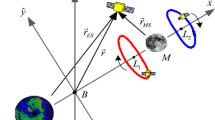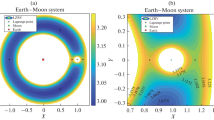Abstract
Intermoon transfers are important components of planetary tour missions. However, these transfers are challenging to design due in part to the chaotic environment created by the multi-body dynamics. The specific objective of this work is to develop a systematic methodology to find fuel optimal, near ballistic Halo-to-Halo trajectories between planetary moons, and we achieve this goal by combining dynamical systems theory with a variety of nonlinear programming techniques. The spacecraft is constrained to start at a Halo orbit of a moon and end at another Halo orbit of a second moon. Our approach overcomes the obstacles of the chaotic dynamics by combining multiple “resonant-hopping” gravity assists with manifolds that control the low-energy transport near the Halo orbits of the moons. To help construct good initial guesses, contours of semimajor axes that can be reached by falling off a Halo orbit are presented. An empirical relationship is then derived to find quickly the boundary conditions on the Halo orbits that lead to ballistic capture and escape trajectories, and connect to desired resonances. The overall optimization procedure is broken into four parts of increasing fidelity: creation of the initial guess from unstable resonant orbits and manifolds, decomposition and optimization of the trajectory into two independent ideal three-body portions, end-to-end refinement in a patched three-body model, and transition to an ephemeris model using a continuation method. Each step is based on a robust multiple shooting approach to reduce the sensitivities associated with the close approach trajectories. Numerical results of an intermoon transfer in the Jovian system are presented. In an ephemeris model, using only 55 m/s and 205 days, a spacecraft can transfer between a Halo orbit of Ganymede and a Halo orbit of Europa.
Similar content being viewed by others
References
Europa Jupiter System Missions, NASA/ESA Joint Summary Report, Jan. 2009.
Jupiter Ganymede Orbiter: ESA Contribution to the Europa Jupiter System Missions, Assessment Study Report ESA-SRE(2008)2, Feb. 2009.
JOHANNESEN, J. and D’AMARIO, L. “Europa Orbiter Mission Trajectory Design,” Advances in the Astronautical Sciences, Vol. 103, No. 1, AAS 99-360, 1999, pp. 895–908.
HEATON, A.F., STRANGE, N.J., LONGUSKI, J.M., and BONFIGLIO, E.P. “Automated Design of the Europa Orbiter Tour.” Journal of Spacecraft and Rockets 39, 1 (Jan. 2002), 17–22.
RENARD, P., KOECK, C., KEMBLE, S., ATZEI, A., and FALKNER, P. “System Concepts and Enabling Technologies for an ESA Low-Cost Mission to Jupiter/Europa.” Presented as paper IAC-04-Q.2.A.02, 2004. 55th International Astronautical Congress, Vancouver, British Columbia, Oct. 4–8.
BOUTONNET, A., PASCALE, P.D., and CANALIAS, E. “Design of the Laplace Mission.” Presented as paper IAC-08-C1.6, 2008. 59th International Astronautical Congress, Glasgow, Scotland, Sep. 29–Oct. 3.
LANGEVIN, Y. “Mission Design Issues for the European Orbiter of ESJM/LAPLACE: Callisto Flybys Sequence.” Advances in the Astronautical Sciences 135, 2 (2009), 967–986, No. AAS 09-359.
KHAN, M., CAMPAGNOLA, S., and CROON, M. “End-to-End Mission Analysis for a Low-Cost, Two-Spacecraft Mission to Europa.” Advances in the Astronautical Sciences 119, 1 (2004), 463–472. No. AAS 04-132.
SWEETSER, T., MADDOCK, T.R., JOHANNESEN, J., BELL, J., WEINSTEIN, S., et al. “Trajectory Design for a Europa Orbiter Mission: a Plethora of Astrodynamic Challenges.” Advances in the Astronautical Sciences 95, 2 (1997), 901–920. No. AAS 97-174.
SIMS, J.A., LONGUSKI, J.M., and STAUGLER, A.J. “Vinfinity Leveraging for Interplanetary Missions: Multiple-Revolution Orbit Techniques.” Journal of Guidance, Control, and Dynamics 20, 3 (May 1997), 409–415.
CAMPAGNOLA, S. and RUSSELL, R.P. “The Endgame Problem Part 1; V-infinity Leveraging Technique and the Leveraging Graph.” Journal of Guidance, Control, and Dynamics 33, 2 (2010), 463–475.
WOOLLEY, R. Endgame Strategies for Planetary Moon Orbiters. PhD thesis, Department of Aerospace Engineering Sciences, University of Colorado, Boulder, CO, 2010.
BRINCKERHOFF, A.T. and RUSSELL, R.P. “Pathfinding and V-Infinity Leveraging for Planetary Moon Tour Missions.” Advances in the Astronautical Sciences 134, 3 (2009), 1833–1850. No. AAS 09-222.
STRANGE, N.J., CAMPAGNOLA, S., and RUSSELL, R.P. “Leveraging Flybys of Low Mass Moons to Enable an Enceladus Orbiter.” Advances in the Astronautical Sciences 135, 3 (2009), 2207–2226. No, AAS 09-435.
CAMPAGNOLA, S., STRANGE, N.J., and RUSSELL, R.P. “A fast tour design method using non-tangent v-infinity leveraging transfers.” Celestial Mechanics and Dynamical Astronomy 108, 2 (2010), 165–186.
WOOLLEY, R.C. and SCHEERES, D.J. “Optimal pathways for sequences of v-infinity leveraging maneuevers.” Advances in the Astronautical Sciences 136, 2 (2010), 1747–1766. No. AAS 10-219.
CAMPAGNOLA, S. and RUSSELL, R.P. “The Endgame Problem Part 2: Multi-Body Technique and T-P Graph.” Journal of Guidance, Control, and Dynamics 33, 2 (2010), 476–486.
GOMEZ, G., KOON, W.S., LO, M.W., MARSDEN, J.E., MASDEMONT, J., and ROSS, S.D. “Connecting orbits and invariant manifolds in the spatial restricted three-body problem.” Nonlinearity 17, 5 (Sept. 2004), 1571–1606.
HOWELL, K.C., BARDEN, B.T., and LO, M.W. “Application of Dynamical Systems Theory to Trajectory Design for a Libration Point Mission.” The Journal of the Astronautical Sciences 45, 2 (June 1997), 161–178.
BELBRUNO, E. “A Low Energy Lunar Transportation System Using Chaotic Dynamics.” Advances in the Astronautical Sciences 123, 3 (2005), 2059–2066. No. AAS 05-382.
LO, M.W. “The Lunar L1 Gateway: Portal to the Stars and Beyond.” Presented as paper 2001-4768, 2001. AIAA Space Conference, Albuquerque, New Mexico.
RUSSELL, R.P. and LAM, T. “Designing Ephemeris Capture Trajectories at Europa Using Unstable Periodic Orbits.” Journal of Guidance, Control, and Dynamics 30, 2 (2007), 482–491.
ROSS, S.D., KOON, W.S., LO, M.W., and MARSDEN, J.E. “Design of a Multi-Moon Orbiter.” Advances in the Astronautical Sciences 114, 1 (2003), 669–684. No. AAS 03-143.
KOON, W.S., LO, M.W., MARSDEN, J.E., and ROSS, S.D. “Constructing a Low Energy Transfer Between Jovian Moons.” Contemporary Mathematics 292 (2002), 129–145.
LO, M.W. “The Interplanetary Superhighway and the Origins Program,” Mar. 2002. IEEE Aerospace Conference, Big Sky, MT.
YAMATO, H. and SPENCER, D.B. “Orbit Transfer Via Tube Jumping in Planar Restricted Problems of Four Bodies.” Journal of Spacecraft and Rockets 42, 2 (2005), 321–328.
ANDERSON, R.L. Low Thrust Trajectory Design for Resonant Flybys and Captures Using Invariant Manifolds. PhD thesis, University of Colorado, 2005.
GOMEZ, G., KOON, W.S., LO, M.W., MARSDEN, J.E., MASDEMONT, J., and ROSS, S.D. “Invariant manifolds, the spatial three-body problem and space mission design.” Advances in the Astronautical Sciences 109, 1 (2001), 3–22. No. AAS 01-301.
GROVER, P. and ROSS, S.D. “Designing Trajectories in a PlanetMoon Environment using the Controlled Keplerian Map.” Journal of Guidance, Control, and Dynamics 32, 2 (Mar. 2009), 437–444.
LANTOINE, G., RUSSELL, R.P., and CAMPAGNOLA, S. “Optimization of Low-Energy Resonant Hopping Transfers between Planetary Moons.” Acta Astronautica, Vol. 68, No. 7–8, 2011, doi:10.1016/j.actaastro.2010.09.021.
LARA, M. and RUSSELL, R. “Computation of a Science Orbit About Europa.” Journal of Guidance, Control, and Dynamics 30, 1 (2007), 259–263.
DAVIS, K.E. Locally Optimal Transfer Trajectories Between Libration Point Orbits Using Invariant Manifolds. PhD thesis, Department of Aerospace Engineering Sciences, University of Colorado, Boulder, CO, 2009.
ROSS, S.D. and SCHEERES, D.J. “Multiple Gravity Assists, Capture, and Escape in the Restricted Three-Body Problem.” SIAM J. Applied Dynamical Systems 6, 3 (July 2007), 576–596.
SCHROER, C.G. and OTT, E. “Targeting in Hamiltonian Systems That Have Mixed Regular/Chaotic Phase Spaces.” Chaos: An Interdisciplinary Journal of Nonlinear Science 7, 4 (Dec. 1997), 512–519.
HOWELL, K.C., BARDEN, B.T., WILSON, R.S., and LO, M.W. “Trajectory Design Using a Dynamical Systems Approach With Application to Genesis.” In Proceedings of the AAS/AIAA Astrodynamics Conference (Sun Valley, Aug. 1997), AIAA, pp. 1665–1684.
KOON, K.S., LO, M.W., MARSDEN, J.E., and ROSS, S.D. Dynamical Systems, the Three-Body Problem and Space Mission Design. Marsden Books, 2008. ISBN 978-0-615-24095-4.
PETROPOULOS, A.E. and RUSSELL, R.P. “Low-Thrust Transfers Using Primer Vector Theory and a Second-Order Penalty Method.” No. AIAA-2008-6955, Aug. 2008. AAS/AIAA Astrodynamics Specialist Conference and Exhibit, Honolulu, HI.
KOLEMEN, E., KASDIN, J.N., and GURFIL, P. “Quasi-Periodic Orbits of the Restricted Three-Body Problem Made Easy.” In Proceedings of the 3rd International Conference on New Trends in Astrodynamics and Applications (Princeton, NJ, USA, 2007), vol. 886, AIP Conference Proceedings, pp. 68–77.
MASDEMONT, J.J. “High-Order Expansions of Invariant Manifolds of Libration Point Orbits With Applications to Mission Design.” Dynamical Systems 20, 1 (Mar. 2005), 59–113.
HOWELL, K., BECKMAN, M., PATTERSON, C., and FOLTA, D. “Representations of Invariant Manifolds for Applications in Three-Body Systems.” Advances in the Astronautical Sciences 119, 3 (2004), 2951–2970. No. 04-287.
GOMEZ, G., LLIBRE, J., MARTINEZ, R., and SIMÓ, C. Dynamics and Mission Design Near Libration Points Volume I: Fundamentals: The Case of Collinear Libration Points, vol. 2 of World Scientific Monograph Series in Mathematics. World Scientific Publishing Co. Inc., River Edge, NJ, 2001.
FLOQUET, G. “Sur les équations différentielles linéaires àè coefficients périodiques.” Annales Scientifiques de l’ENS 12 (1883), 47–88.
SHINBROT, T., OTT, E., GREBOGI, C., and YORKE, J.A. “Using Chaos to Direct Trajectories To Targets.” Physical Review Letters 65 (Dec. 1990), 3215–3218.
MORRISON, D.D., RILEY, J.D., and ZANCANARO, J.F. “Multiple Shooting Method for Two-Point Boundary Value Problems.” Communications of the ACM 5, 12 (Dec. 1962), 613–614.
LANTOINE, G. and RUSSELL, R.P. “A Unified Framework for Robust Optimization of Interplanetary Trajectories.” No. AIAA-2010-7828, Aug. 2010. AIAA/AAS Astrodynamics Speciahst Conference, Toronto, Ontario, Canada.
GILL, P.E., MURRAY, W., and SAUNDERS, M.A. SNOPT: An SQP Algorithm for Large-Scale Constrained Optimization. SIAM journal on optimization 12, 4 (2002), 979–1006.
MARTINS, J.R., STURDZA, P., and ALONSO, J.J. “The Complex-Step Derivative Approximation.” ACM Transactions on Mathematical Software 29, 3 (2003), 245–262.
RUSSELL, R.P. and STRANGE, N.J. “Planetary Moon Cycler Trajectories.” Journal of Guidance, Control, and Dynamics 32, 1 (2009), 143–157.
JPL Horizon website, http://ssd.jpl.nasa.gov/?satellites#elem.
BAGENAL, F., DOWLING, T., and MCKINNON, W. Jupiter: The Planet, Satellites and Magnetosphere. Cambridge Planetary Science. Cambridge University Press, 2004.
GAWLIK, E., MARSDEN, J., CAMPAGNOLA, S., and MOORE, A. “Invariant Manifolds, Discrete Mechanics, and Trajectory Design for a Mission to Titan.” Advances in the Astronautical Sciences 134, 3 (2009), 1887–1904. No. 09-226.
Author information
Authors and Affiliations
Corresponding author
Rights and permissions
About this article
Cite this article
Lantoine, G., Russell, R.P. Near Ballistic Halo-to-Halo Transfers between Planetary Moons. J of Astronaut Sci 58, 335–363 (2011). https://doi.org/10.1007/BF03321174
Published:
Issue Date:
DOI: https://doi.org/10.1007/BF03321174




